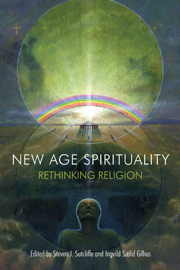Book contents
- Frontmatter
- Contents
- Introduction: “All mixed up” – thinking about religion in relation to New Age spiritualities
- Part I Rethinking New Age spiritualities
- 1 New Age, world religions and elementary forms
- 2 “All over the place”: the contribution of New Age to a spatial model of religion
- 3 Towards a new paradigm of constructing “religion”: New Age data and unbounded categories
- 4 On transgressing the secular: spiritualities of life, idealism, vitalism
- 5 Hiding in plain sight: the organizational forms of “unorganized religion”
- Part II Comparing New Age beliefs and practices
- Part III Putting new spiritual practices to work
- Conclusion: New Age spiritualities – “good to think” in the study of religion
- Contributors
- Further reading
- Bibliography
- Index
5 - Hiding in plain sight: the organizational forms of “unorganized religion”
from Part I - Rethinking New Age spiritualities
- Frontmatter
- Contents
- Introduction: “All mixed up” – thinking about religion in relation to New Age spiritualities
- Part I Rethinking New Age spiritualities
- 1 New Age, world religions and elementary forms
- 2 “All over the place”: the contribution of New Age to a spatial model of religion
- 3 Towards a new paradigm of constructing “religion”: New Age data and unbounded categories
- 4 On transgressing the secular: spiritualities of life, idealism, vitalism
- 5 Hiding in plain sight: the organizational forms of “unorganized religion”
- Part II Comparing New Age beliefs and practices
- Part III Putting new spiritual practices to work
- Conclusion: New Age spiritualities – “good to think” in the study of religion
- Contributors
- Further reading
- Bibliography
- Index
Summary
There has been much debate over whether New Age spirituality (NAS) is a useful category and, if so, how best to characterize the phenomena clustered under that heading. Historically minded scholars generally agree, however, on the value of distinguishing between narrower and broader uses of the term “new age”! In the narrower sense, it refers above all to ideas in the writings of post-Theosophist Alice Bailey (1880–1949), which were picked up by the new age networks of the 1950s, many of them UFO related, and transformed into a more activist form by 1960s utopian communities, most notably Findhorn. Te movement, narrowly conceived, was British-based and relied upon occultist traditions that had long been influential there (Melton 1995; Sutcliffe 2003a; Albanese 2007; Hanegraaff 2009: 345). In a more general sense, scholars have used “new age” as a catch-all term for the much more extensive and complex “cultic milieu” of the 1980s and beyond, which was dominated “by the so-called metaphysical and New Tought traditions typical of American alternative culture” (Hanegraaff 2009: 344–5). Sutcliffe depicts this as “a popular hermeneutical shift in the meaning of ‘New Age’ … [such that] at the turn of the 1970s, … ‘New Age’ as apocalyptic emblem of the near future gave way to ‘New Age’ as humanistic idiom of self-realisation in the here-and-now” (Sutcliffe 2003a: 5).
- Type
- Chapter
- Information
- New Age SpiritualityRethinking Religion, pp. 84 - 98Publisher: Acumen PublishingPrint publication year: 2013



